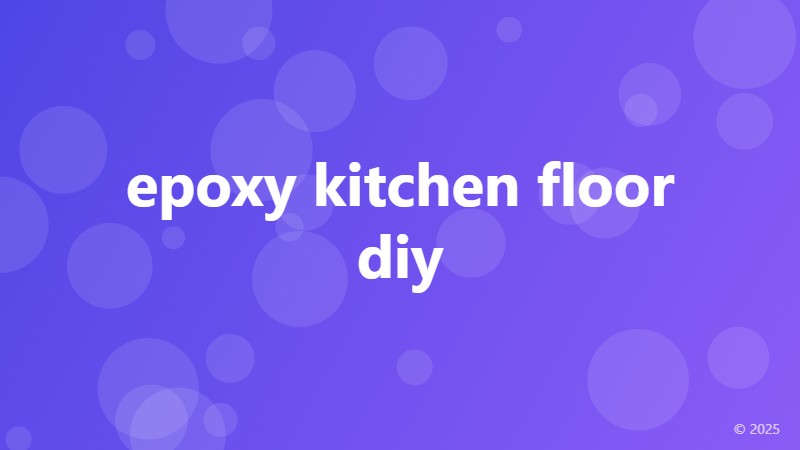epoxy kitchen floor diy

Transform Your Kitchen with an Epoxy Kitchen Floor DIY Project
Are you tired of your outdated kitchen floor? Do you want to give your kitchen a modern and sleek look without breaking the bank? An epoxy kitchen floor DIY project is the perfect solution for you! With epoxy flooring, you can achieve a high-gloss, durable, and easy-to-clean surface that will make your kitchen stand out.
Benefits of Epoxy Kitchen Flooring
Epoxy kitchen flooring offers numerous benefits, including:
- Durability: Epoxy flooring is resistant to scratches, cracks, and fading, making it perfect for high-traffic areas like the kitchen.
- Easy Maintenance: Epoxy flooring is easy to clean and maintain, and it's resistant to stains, spills, and moisture.
- Versatility: Epoxy flooring comes in a wide range of colors and finishes, allowing you to customize your kitchen floor to fit your style.
- Cost-Effective: Compared to other flooring options, epoxy flooring is relatively inexpensive, making it a budget-friendly choice for homeowners.
Materials Needed for an Epoxy Kitchen Floor DIY Project
To get started with your epoxy kitchen floor DIY project, you'll need the following materials:
- Epoxy resin: This is the main component of epoxy flooring, and it's available in various colors and finishes.
- Hardener: This is a catalyst that's mixed with the epoxy resin to create a strong and durable bond.
- Primer: This is an optional material that's used to prepare the surface of your existing floor for the epoxy coating.
- Roller extension pole: This is a tool that's used to apply the epoxy coating evenly and smoothly.
- Protective gear: This includes gloves, goggles, and a mask to protect yourself from the chemicals and fumes involved in the process.
Step-by-Step Guide to an Epoxy Kitchen Floor DIY Project
Here's a step-by-step guide to help you get started with your epoxy kitchen floor DIY project:
- Prepare the surface: Clean and degrease your existing floor to ensure a strong bond between the epoxy coating and the surface.
- Mix the epoxy resin and hardener: Follow the manufacturer's instructions to mix the epoxy resin and hardener in the right ratio.
- Apply the primer (optional): If you're using a primer, apply it to the surface of your existing floor according to the manufacturer's instructions.
- Apply the epoxy coating: Use the roller extension pole to apply the epoxy coating evenly and smoothly, working in sections to avoid drips and puddles.
- Allow it to cure: Let the epoxy coating cure for the recommended amount of time, usually several hours or overnight.
- Apply a second coat (optional): If you want a higher-gloss finish, you can apply a second coat of epoxy coating following the same process as before.
- Seal the floor (optional): To add an extra layer of protection to your epoxy kitchen floor, you can apply a clear sealant according to the manufacturer's instructions.
Common Mistakes to Avoid in an Epoxy Kitchen Floor DIY Project
To ensure a successful epoxy kitchen floor DIY project, avoid the following common mistakes:
- Not preparing the surface properly: Failing to clean and degrease the surface can lead to a weak bond between the epoxy coating and the surface.
- Mixing the epoxy resin and hardener incorrectly: Following the manufacturer's instructions is crucial to achieving a strong and durable bond.
- Applying the epoxy coating too thickly: This can lead to drips, puddles, and an uneven finish.
- Not allowing the epoxy coating to cure properly: Rushing the process can lead to a weak and fragile finish.
By following these tips and guidelines, you can achieve a beautiful and durable epoxy kitchen floor that will transform your kitchen and increase its value. With a little patience and effort, you can enjoy a high-gloss, easy-to-clean, and modern kitchen floor that will last for years to come.